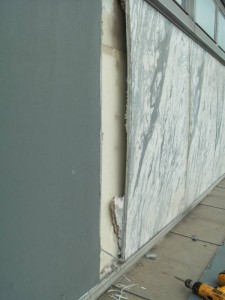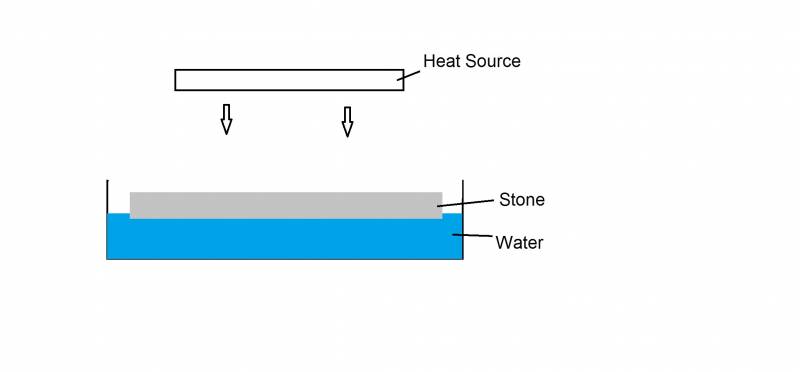Red Sandstone Exterior Cladding NASA Johnson Space Center Building 21, Houston, TX Reminiscent of an Southwestern Desert skyline, Red Sandstone can be found all over the world in desert and dry areas. Colored by Iron oxide, Red Sandstone has a neutral warm red color. Red sandstone makes for great exterior cladding due to […]
Deterioration Of Marble Facades And Problems With Failed Stone Cladding: The Problem And The Solution
Problems with marble cladding can include bowing, expansion, loss of strength, cracking, and even detachment from the building. Here we will address the cause of and solution to hysteresis and marble facade failure.
If you are involved with a natural stone cladding or facade project that needs restoration, or you are an architect, engineer, owner, or contractor tasked with designing or constructing stone cladding, you want to avoid problems. Several prominent buildings have suffered from the problem of marble facade failure, including the Amoco building in Chicago, the Finlandia City Hall in Helsinki, La Grande Arch and SCOR Tower in Paris, and the IBM Tower in Brussels.
Why Do Some Marble Facades Bow And Warp?
Natural stone has been used for facade applications for centuries. But until relatively recently, the marble was always heavy, 4″ to 8″-thick slabs. These stone panels did not bow, but they placed considerable weight on the building. In the late 1950s, the slab thickness was reduced to 1 1/2″ or so. This reduced the weight of the stone cladding, but introduced some new problems. One of these problems was slab bowing. Over time, some facade slabs bowed to be either convex or concave. The attachment of the slabs, which involved the use of kerf cuts and slots, tended to rely on the weakest property of the stone.
Where On The Building Facade Do Most Stone Failures Occur?
The greatest amount of bowing is on south facing facades. Here, the sun tends to cycle the stone cladding through greater temperature swings.
What Stones Fail, Bow, And Crack In Facade And Cladding Applications?
The marbles most susceptible to bowing are white marbles. These include Italian Carrera marble, but also marbles from Greece, Italy, Portugal, Spain, Norway, China, and the USA. Marbles of the same variety from the same quarry can have a different propensity for bowing. Limestone facade panels generally do not bow, but may expand out of their anchors.
What Climates Cause Stone Facade Failure?
The problem of failure in marble facades is not limited to one climate or one type of marble. In the USA, buildings in several states have had problems. In Europe, there are building facades with bowed marble slabs in both the cooler climates of Finland and Denmark and the warmer climates of Portugal and Spain. Bowed slabs can also be found in Austria, Belgium, France, Germany, Greece, Italy, the Netherlands, Norway, Sweden, Switzerland, and the United Kingdom.
Why Does Marble Bow?
Certain marble slabs permanently warp in response to uneven heating and cooling and a moisture variation in the stone. Each day, the sun heats the panel face, causing it to dry out and to expand more than the back of the slab. The inside face of the panel (the surface against the building) remains cooler and more moist. When the crystals within some marbles expand, they do not return all the way back to their original size when cooled. The result is a gradual bowing or cupping of the stone facade panel with each heating/cooling and damp/dry cycle. In addition to the change in shape, the process weakens the stone.
Through lab testing some 80 different marbles, we have found the main external cause of bowing to be uneven solar heating with a moisture gradient. Various marble types respond in different ways to the cycles. This mostly depends upon the microscopic crystal patterns within a marble and how the grains are “locked” together.
What Is The Solution To Marble Cladding Bowing And Deterioration?
The solution is to use StonePly natural stone panels instead of slab marble. StonePly combines a thin 1/4″ layer of natural stone bonded to aluminum honeycomb backing. The StonePly panel relies on the aluminum honeycomb for strength and rigidity, not on the stone. Natural stone panel testing has proven that StonePly panels do not suffer the same thermal hysteresis problem as slab stone.
Tested And Proven
StonePly has been tested using the European procedure for testing for stone slab bowing. In the test, the slab is partially submerged in water. The unsubmerged face of the slab is exposed to radiant heat. The slab is subjected to repeated cycles of heating and cooling. In testing, 40 cycles are considered sufficient to show if the marble has a tendency to bow. After 200 cycles, StonePly showed no discernible bowing or warping.
Laboratory Testing
Real World Testing
The panels on the Entergy Building failed. The owner replaced them with StonePly panels of the same stone variety and eliminated the problem. You can view the case study here.
For More StonePly Information
To find out more about how our lightweight natural stone panels can allow you to vastly reduce the risk of stone failure and prevent thermal hysteresis, visit the StonePly website. If you are interested in discussing your stone panel needs during a free initial consultation and obtaining a no-charge custom estimate, contact us. We have a simple form on our contact page for potential clients, or you can call us at 903-454-4630.


No comments yet.